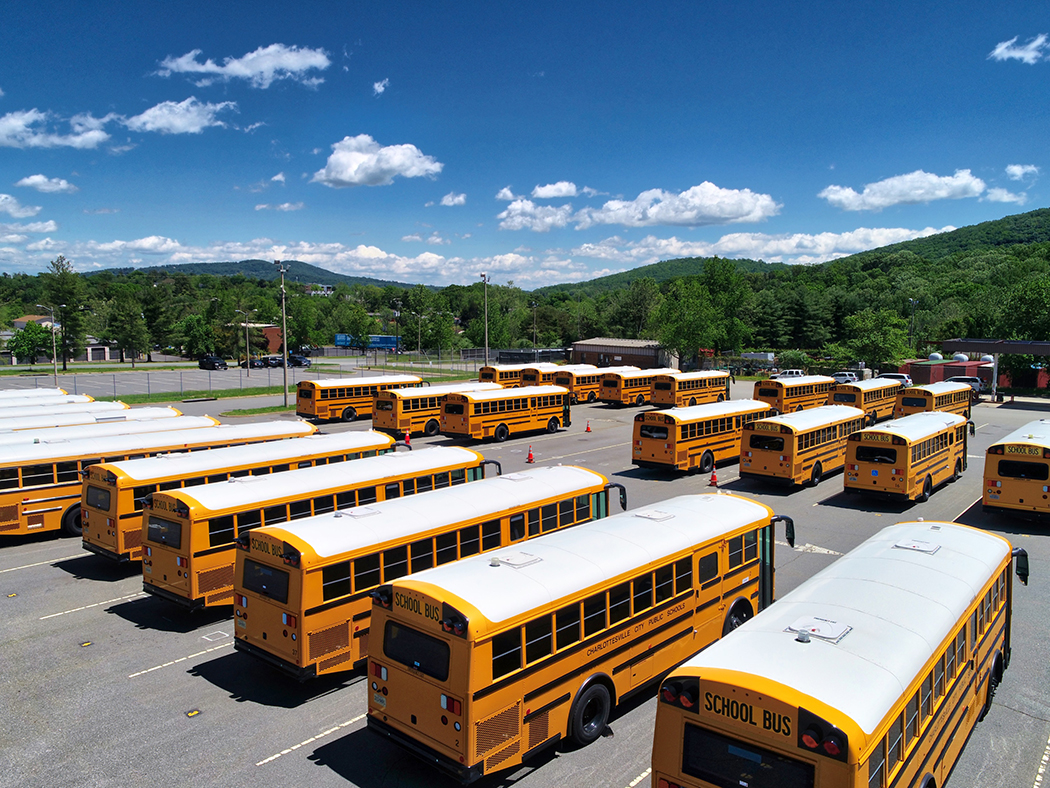By Mary Jane Gore
The wheels on the bus go ’round and ’round—until COVID hits. And since the start of the pandemic, city and county bus systems have encountered many bumps and unexpected curves.
Before COVID, the city averaged about 2,600 bus riders per day. Currently, that number is down to 1,033, and some buses are becoming emptier as ridership dwindles along certain routes. High schools in particular have light loads in some areas, as parents and some students have opted to drive.
Fluctuation in the number of students who ride—and where they live—has meant constant adjusting for drivers.
Typically, the school systems conduct one routing per school year. In 2020-2021, the Albemarle County schools routing staff used software (and bus drivers’ valuable knowledge) to generate five different routing schedules, as situations changed rapidly.
Donna Fortune says the county, where she has driven for 11 years, was supportive when drivers returned to deliver students to in-person classes again. And she was happy to be behind the wheel again after being “heartbroken” when buses were suspended in 2020, because she missed her young passengers.
“We were given good transportation and routing information,” Fortune says. “We received lists of all students, and what day of the week they are riding.” Learning the new, complicated routes wasn’t easy, though. Some kids go to school on Monday and Wednesday, some go on Tuesday and Thursday, and some go all four of those days.
On Fridays, when most students attend school remotely, county buses shuttle supplies to kids—books, projects, equipment, paperwork—so they can work effectively at home. Buses also deliver lunch to those who need it.
Drivers are worn out in general, says ACPS Transportation Director Jim Foley. Often, they drive two shifts each morning and afternoon to accommodate both elementary and middle/high school students. The drivers have also been tasked with disinfecting the bus, and are expected to enforce the mask requirement, which is tricky. Fortune says the kids have been excited to see each other, and are very talkative. “They enjoy socializing,” she says.
Some bus routes have few or zero kids on them, and others have had waitlists for seats, though the city school district says it has “been able to meet all known needs for students of families who elected in-person school and require bus service to attend.”
In the county, the largest bus holds 77 students, but during COVID that number shrunk to 25 with distancing, says Foley. All area buses have a one-child-per-seat policy, except for siblings, who can ride two to a seat.
Foley says that children cannot pick and choose when they ride the bus. “If a student is not on the bus for 10 days and that information is verified with parents or through the schools, then that child would be removed as a bus rider, and someone on the waiting list would get a bus seat,” he says. The city follows a similar process for its routes.
Both districts have had difficulty recruiting drivers. Decreased bus ridership does not mean fewer drivers are required—routes cover significant ground and in many cases cannot be combined. The city was recruiting pre-pandemic, but the issue has worsened due to driver retirements and ongoing challenges with COVID-19.
Foley encourages people to apply for the now-$16-per-hour job. Drivers can gain Virginia Retirement System benefits with just six hours per day, he says. With a minimum five hours a day, 10 months a year, a driver gets health care benefits too.
And riding the bus is better for the environment and safer than individual transportation: Foley says each full bus would keep about 36 cars from driving to schools—and school-provided transportation is eight times safer than parent transportation and 40 times safer than teen transportation.
Looking ahead, the city hopes to find more drivers for an anticipated summer school. The county plans to begin allowing two students per seat this summer.
The county also plans to install new federally funded air filtration systems by the fall, Foley says. The HEPA systems are the same that airplanes use, and would make riding safer for more students at once.
Meanwhile, school districts anxiously await news of expanded access to vaccines—Pfizer is expected to soon authorize its vaccine for use on children as young as 12. Phil Giaramita, ACPS strategic communications officer, says the schools will continue to adjust their transportation plans based on the experts’ vaccine recommendations.
